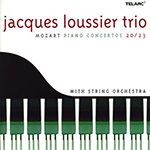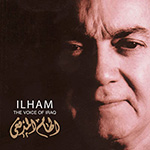 For a double bill of Classical and Jazz plus high production values, this meant Telarc with the Jacques Loussier Trio plus string orchestra doing Mozart's Piano Concertos #20/23. For some reason I now tuned first into how fundamentally similar these amps were in their sweetness. Coming off the Bakoon, Crayon and Goldmund/Job aesthetic as my benchmarks for 'Swiss' sound, that was nearly minor lushness. It's an aspect where tube notions could justifiably arise should one's idea of solid state be synonymous with a leaner more agitated aesthetic. That tube amps of my acquaintance generally aren't as linear, quiet and in control is another matter. But it explains why rather than to actual valve amps, I transitioned to Pass Labs and FirstWatt. Their amps do some of the things I like about tubes without any of the things I really don't. By now I was quite certain where to look. With the XA25, the higher orchestral background violins here and there showed just a touch more horse hairs as their metallic/glassy not wooden/creamy trait. This led to the impression of elevated image lock or being better separated out from the mix. Still, the overriding takeaway from this session was more how the amps overlap, not where they diverge. The key word of agreement between XA-30.8 and XA25 was sonorous.
For a double bill of Classical and Jazz plus high production values, this meant Telarc with the Jacques Loussier Trio plus string orchestra doing Mozart's Piano Concertos #20/23. For some reason I now tuned first into how fundamentally similar these amps were in their sweetness. Coming off the Bakoon, Crayon and Goldmund/Job aesthetic as my benchmarks for 'Swiss' sound, that was nearly minor lushness. It's an aspect where tube notions could justifiably arise should one's idea of solid state be synonymous with a leaner more agitated aesthetic. That tube amps of my acquaintance generally aren't as linear, quiet and in control is another matter. But it explains why rather than to actual valve amps, I transitioned to Pass Labs and FirstWatt. Their amps do some of the things I like about tubes without any of the things I really don't. By now I was quite certain where to look. With the XA25, the higher orchestral background violins here and there showed just a touch more horse hairs as their metallic/glassy not wooden/creamy trait. This led to the impression of elevated image lock or being better separated out from the mix. Still, the overriding takeaway from this session was more how the amps overlap, not where they diverge. The key word of agreement between XA-30.8 and XA25 was sonorous.

If we consult synonyms, we circle that wagon more tightly. "Vibrant, full-bodied, resounding, majestic, lofty, strong, imposing." In audiophilia the most popular catch-all for that entire bag is probably bloomy. As a quality it sits directly across from overdamped, dry and lean. Considering how well these amps controlled the hidden woofers of these Audio Physic Codex, it could seem surprising that effective bass damping didn't simultaneously dry out the remaining bandwidth. It patently did not to probably point not so much at low output impedance per se but how Pass achieve it. Hence this more redolent general behavior could be another quality which, now arriving especially from the class D school of massive negative feedback, could strike many as more tube than solid state. Obviously such an opinion expresses a narrower exposure to the many flavors transistor sound can offer. But in its limited fashion, it still makes a valid point. Neither of these transistor amps do it dry or metronomic. But as Herb Reichert's Stereophile comments made clear vis-à-vis an 845 Line Magnetic valve amp, tubes still do it different. Now rather than tick off more distinctive points against the XA-30.8, we'll save some for the FirstWatt F7.
 My prior F7 review set up its psych profile. At 20/30wpc into 8/4Ω in class A push/pull, this amp specs smaller. A $3'000 tag continues the theme. Today we just target sonics. That includes playing to the XA25 whose review this is with a 4Ω 4-way whose invisible long-throw woofer loads into the physically smallest possible sub box for very high internal pressurization. A review predisposed toward the F7 should pick an easier load. Commentary on the XA25 simply exploits whatever unfair advantage it might pack by way of a stiffer power supply and more dissipation surface for increased power, headroom and low-Ω drive. That the 89dB Codex is no Magnepan won't be lost on you. Owning punishing loads to need herculean amps simply isn't my idea of a clever investment. So the Audio Physic were the worst I could do. This opened the difference window wider. The most profound offset occurred in the midband; or better put, I first noticed it there when it really encompassed the entire bandwidth but I'd started off with a simple song. Where the XA25 felt glossy with vitality like pearls of sweat projecting actively—what in people we call radiance or charisma—the F7 played more matte, dry and by contrast almost passive, reserved or introspective. As such it also felt more distanced and set back. A side effect was that background sounds like the sparse atmospherics behind legendary Iraqi singer Ilham Al Madfai's plaintive love song to the city of Baghdad weren't as integral as they were with the XA25. To overwrite, they nearly moved outside the stage's rear lights. They were there but not here. It made for a fundamentally different relationship between listener and music. The F7's greater passivity spoke more to the observer perspective. The XA25's peculiar action triggered that of a participant; ex Stereophile writer Chip Stern's lap-dance factor.
My prior F7 review set up its psych profile. At 20/30wpc into 8/4Ω in class A push/pull, this amp specs smaller. A $3'000 tag continues the theme. Today we just target sonics. That includes playing to the XA25 whose review this is with a 4Ω 4-way whose invisible long-throw woofer loads into the physically smallest possible sub box for very high internal pressurization. A review predisposed toward the F7 should pick an easier load. Commentary on the XA25 simply exploits whatever unfair advantage it might pack by way of a stiffer power supply and more dissipation surface for increased power, headroom and low-Ω drive. That the 89dB Codex is no Magnepan won't be lost on you. Owning punishing loads to need herculean amps simply isn't my idea of a clever investment. So the Audio Physic were the worst I could do. This opened the difference window wider. The most profound offset occurred in the midband; or better put, I first noticed it there when it really encompassed the entire bandwidth but I'd started off with a simple song. Where the XA25 felt glossy with vitality like pearls of sweat projecting actively—what in people we call radiance or charisma—the F7 played more matte, dry and by contrast almost passive, reserved or introspective. As such it also felt more distanced and set back. A side effect was that background sounds like the sparse atmospherics behind legendary Iraqi singer Ilham Al Madfai's plaintive love song to the city of Baghdad weren't as integral as they were with the XA25. To overwrite, they nearly moved outside the stage's rear lights. They were there but not here. It made for a fundamentally different relationship between listener and music. The F7's greater passivity spoke more to the observer perspective. The XA25's peculiar action triggered that of a participant; ex Stereophile writer Chip Stern's lap-dance factor.

Using Photoshop's basic level command to point at the same phenomenon in light-related lingo, we'd say that the F7 moved the white cursor to the left to increase that value whilst the XA25 slid the black cursor up a tick and also the middle cursor to deepen transitional hues. In color terms the FirstWatt was paler, the Pass more saturated and intense. This points back at the earlier matte/gloss polarity and the more restrained versus radiant action. It gives us three different points of view all processing the same difference in language specific to one's focus or trigger. Those who first key into tone density would name the F7 more lightweight, the XA25 heavier and earthier. On that score it's vital not to correlate lightweight with more light-infused. That'd make the XA25 darker which is not how I heard it. To my ears that aspect didn't factor because of its projecting action. Darkness obscures and eventually disconnects. Light projects and connects us to what we see. The XA25 was more not less informative.